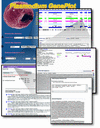PlasmoDB: the Plasmodium genome resource. A database integrating experimental and computational data
- PMID: 12519984
- PMCID: PMC165528
- DOI: 10.1093/nar/gkg081
PlasmoDB: the Plasmodium genome resource. A database integrating experimental and computational data
Abstract
PlasmoDB (http://PlasmoDB.org) is the official database of the Plasmodium falciparum genome sequencing consortium. This resource incorporates the recently completed P. falciparum genome sequence and annotation, as well as draft sequence and annotation emerging from other Plasmodium sequencing projects. PlasmoDB currently houses information from five parasite species and provides tools for intra- and inter-species comparisons. Sequence information is integrated with other genomic-scale data emerging from the Plasmodium research community, including gene expression analysis from EST, SAGE and microarray projects and proteomics studies. The relational schema used to build PlasmoDB, GUS (Genomics Unified Schema) employs a highly structured format to accommodate the diverse data types generated by sequence and expression projects. A variety of tools allow researchers to formulate complex, biologically-based, queries of the database. A stand-alone version of the database is also available on CD-ROM (P. falciparum GenePlot), facilitating access to the data in situations where internet access is difficult (e.g. by malaria researchers working in the field). The goal of PlasmoDB is to facilitate utilization of the vast quantities of genomic-scale data produced by the global malaria research community. The software used to develop PlasmoDB has been used to create a second Apicomplexan parasite genome database, ToxoDB (http://ToxoDB.org).
Figures

References
-
- Kissinger J.C., Brunk,B.P., Crabtree,J., Fraunholz,M.J., Gajria,B., Milgram,A.J., Pearson,D.S., Schug,J., Bahl,A., Diskin,S.J. et al. (2002) PlasmoDB: The Plasmodium genome resource. Nature, 419, 490–492. - PubMed
-
- Florens L., Washburn,M.P., Raine,J.D., Anthony,R.M., Grainger,M., Haynes,J.D., Moch,J.K., Muster,N., Sacci,J.B., Tabb,D.L. et al. (2002) A proteomic view of Plasmodium falciparum life cycle. Nature, 419, 520–526. - PubMed
-
- Mu J., Duan,J., Makova,K.D., Joy,D.A., Huynh,C.Q., Branch,O.H., Li,W.H. and Su,X.Z. (2002) Chromosome-wide SNPs reveal an ancient origin for Plasmodium falciparum. Nature, 418, 323–326. - PubMed
Publication types
MeSH terms
Grants and funding
LinkOut - more resources
Full Text Sources
Research Materials

